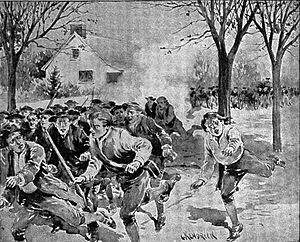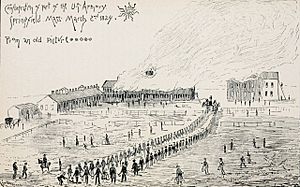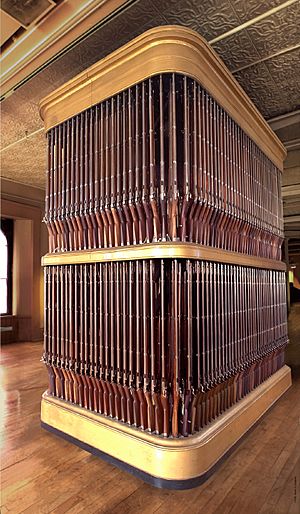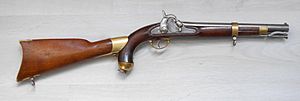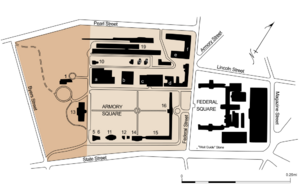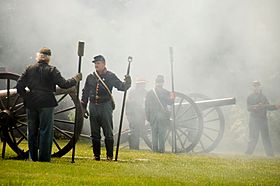Springfield Armory facts for kids
|
Springfield Armory National Historic Site
|
|
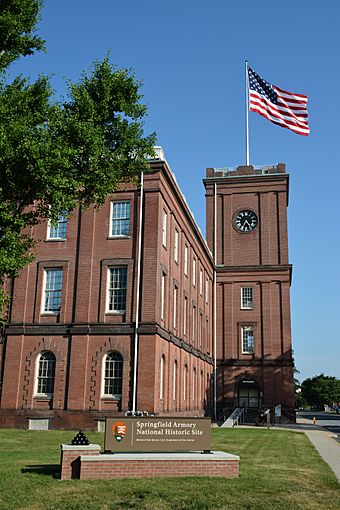
The clocktower of the Main Arsenal building, built in 1847
|
|
| Location | Armory Sq., Springfield, Massachusetts, United States |
|---|---|
| Area | 54.93 acres (0.2223 km2) |
| Built | 1778 |
| Architectural style | Greek Revival |
| Website | Springfield Armory National Historic Site |
| NRHP reference No. | 66000898 |
Quick facts for kids Significant dates |
|
| Added to NRHP | October 15, 1966 |
| Designated NHLD | December 19, 1960 |
The Springfield Armory was a very important place in American history. It was the main factory for making military firearms (guns) for the United States government. Located in Springfield, Massachusetts, it operated from 1777 until 1968.
This armory was the first federal (national) factory in the U.S. dedicated to making weapons. Today, the site is a special place called the Springfield Armory National Historic Site. It's part of the National Park Service and has the world's largest collection of old American firearms.
The Springfield Armory was famous during the American Revolutionary War. It also played a big role in Shays' Rebellion. Over the years, it became a center for new ideas and technology. Important inventions like interchangeable parts and the assembly line for mass production were developed here.
During the American Civil War, the armory made most of the weapons for the Union army. It produced 32 times more firearms than the Confederate states. Historians say its advanced manufacturing helped start the Second Industrial Revolution. The many types of guns made here are known as "Springfield muskets and rifles."
Contents
How the Armory Started (1777)
Long before the armory, local groups used this high ground for military training. This was especially true after an attack on Springfield during King Philip's War in the 1600s.
Why Springfield Was Chosen
In 1777, during the American Revolutionary War, George Washington chose this spot for the armory. His artillery chief, General Henry Knox, suggested it. Springfield was a small town but had great advantages. It was where three rivers met, including the big Connecticut River. Four main roads led from there to major cities like New York and Boston.
Springfield was also safe from attacks by ships. It was just north of the Connecticut River's first waterfall. This waterfall was too steep for ocean-going ships to pass. So, Springfield was protected from naval attacks. The armory itself sat on a high bluff, like a fortress, overlooking the river. General Knox agreed it was "one of the most proper spots" for an arsenal.
Early Days and Purpose
In 1777, American colonists built "The Arsenal at Springfield." They made cartridges (bullets) and gun carriages (parts for cannons) for the war. The arsenal also stored muskets, cannons, and other weapons. They built barracks (housing for soldiers), shops, and storage buildings. After the war, the Army kept the site to store weapons for future needs. By the 1780s, it was a major storage place for ammunition and weapons.
Later, when making weapons became important, the armory grew. It expanded to a second area in Springfield where water power was available. A dam was built on the Mill River, creating Watershops Pond. The main workshops were behind this dam. This factory was updated and used to make many parts for Springfield and Garand rifles.
President George Washington chose David Ames as the first leader of the armory. David's father, Captain John Ames, was a blacksmith who made guns for the colonial army.
Shays' Rebellion (1787)
In 1786 and 1787, a veteran of the Revolutionary War named Daniel Shays led an uprising. He and his followers, called "Shays' Regulators," were upset with the Government of Massachusetts. They marched on the Springfield Armory on January 25, 1787. They hoped to steal its weapons and force changes in the government.
State militia defended the armory that day. They fired grapeshot (small metal balls) from cannons at the rebels. This forced Shays' forces to run away. This event was a turning point, and Shays' Rebellion ended soon after. Some participants were even tried for treason.
Shays' Rebellion greatly influenced the leaders who wrote the U.S. Constitution. George Washington said it was why he came out of retirement to help. During the debates, James Madison warned that "the rebellion in Massachusetts is a warning, gentlemen." He used it to argue for a stronger national government.
Making Weapons (1795–1968)
First Muskets and Early Innovations
In 1793, the national arsenal held many military supplies. These included cannons, howitzers, cannon parts, various types of shot, powder, and muskets. In 1795, the Springfield Armory made the new nation's first musket. This was the Model 1795 Musket, similar to the French Charleville musket used in the American Revolution.
The armory was very important for providing weapons during the War of 1812. In 1814, it made almost 9,600 new muskets and fixed over 5,000 old ones.
Springfield quickly became a hub for new inventions. In 1819, Thomas Blanchard created a special lathe. This machine could consistently make many identical rifle stocks (the wooden part of a rifle). Blanchard worked at the armory for five years. His lathe allowed workers to easily create exact copies of rifle parts.
In the 1840s, old flintlock guns were replaced by a percussion system. This made long guns more reliable and simpler to use.
The Industrial Revolution and New Ideas
The Springfield Armory played a big part in the Industrial Revolution. This was partly because the military wanted "interchangeable parts." The idea was that it would be easier to replace a broken gun part than to fix it on the battlefield. Making truly interchangeable parts required more machines, better quality checks, and dividing up the work. These were all key features of the Industrial Revolution. From these ideas, the concept of the assembly line was born.
The armory also improved how businesses were run. Colonel Roswell Lee, who became superintendent in 1815, brought in new methods. He created a central authority, tracked costs for pay, time, and materials, and increased discipline. These are all business practices still used today.
In 1843, the poet Henry Wadsworth Longfellow visited the armory. He wrote his famous anti-war poem, "The Arsenal at Springfield." He described the rows of guns, over a million of them, stored upright. He wrote, "Like a huge organ, rise the burnished arms."
Civil War and Beyond
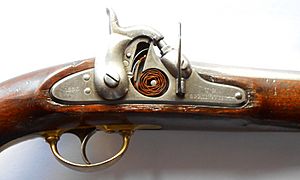
When the American Civil War began, the Harpers Ferry Armory was destroyed. For a short time, the Springfield Armory was the only government factory making weapons. Production grew incredibly fast. In 1860, it made 9,601 rifles. By 1864, it made 276,200! This huge increase gave the Union army a big advantage. It also showed how mass production could work.
In 1865, Master Armorer Erskine Allin created the "Allin Conversion." This changed older muzzleloaders into more advanced breech-loading guns. This made the old guns useful for longer. In 1891, the armory also became the army's main lab for testing new small arms.
One unique part of the armory is its fence. It was started after the Civil War and finished in 1890. Major James W. Ripley couldn't get money for a fence. So, he asked for old cannons from government storage, some from the Revolutionary War. He had them melted down. The metal was then shaped into 9-foot tall spikes and spearheads. These were set into a red sandstone base, creating a very strong and unusual fence.
20th Century Innovations
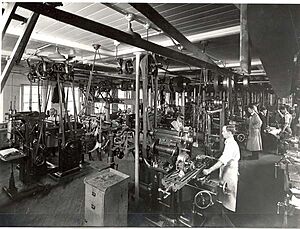
During the Spanish–American War, American soldiers saw that Spanish rifles were better. So, in 1900, Springfield Armory created a new rifle, the Model 1903. It had a special magazine inside the stock to protect the cartridges. This design was so good that the German company Mauser, which had a similar patent, sued Springfield and won royalties.
By the time the United States entered World War I in 1917, over 843,000 Model 1903 rifles had been made. But this wasn't enough for all the troops. During the war, Springfield Armory made over 265,000 more Model 1903 rifles. They also made about 25,000 M1911 pistols before focusing only on rifles.
In 1919, a talented inventor named John Garand came to Springfield. He worked to create a semi-automatic rifle (a gun that reloads itself after each shot). After five years, he designed the famous M1, or "Garand rifle." The army approved it in 1936, and production began the next year. This was the biggest production effort in the armory's history. The Springfield Armory made over 4.5 million M1 rifles.
The M1 was praised for its accuracy and toughness in battle. General Douglas MacArthur said it worked perfectly in combat, even in dusty conditions. General George S. Patton, Jr. called it "the greatest battle implement ever devised."
Later Years and Closure
The last small arm developed by the armory was the M14 rifle. This was an improved version of the M1 Garand. The M14 was made from 1959 to 1964. It was the main combat rifle for the U.S. Army until the M16 rifle replaced it. The M14 has since been updated into a modern sniper rifle, the M21.
By the time of the Vietnam War, Springfield Armory was developing many types of weapons. These included rifles, machine guns, and grenade launchers. Many of these were designed at the armory but built by private companies. This showed a shift towards private companies making weapons for the military.
Becoming a National Historic Site (1968–Present)
In 1968, the Springfield Armory closed its doors. Parts of the armory, like the "Water Shops" production buildings, were sold off. These shops are now listed on the National Register of Historic Places. The main part of the armory was saved and given to the city and state.
Today, it is the Springfield Armory National Historic Site. The National Park Service manages it. Since 2011, the land behind the armory and some of its old buildings are home to Springfield Technical Community College (STCC). This college continues the tradition of technological innovation at the site.
The Main Arsenal Building and the Commanding Officer's Quarters were carefully restored between 1987 and 1991. The Main Arsenal now holds the Springfield Armory Museum. It features the Benton Small Arms Collection, which is one of the largest collections of weapons in the world.
The Name "Springfield Armory" Today
After the government's Springfield Armory closed in 1968, a company called L. H. Gun Co. changed its name. It became Springfield Armory, Inc. They did this to use the famous name. However, this commercial company has no connection to the original government armory. They make products like M1911 pistols and the M1A rifle series.
See also
 In Spanish: Springfield Armory para niños
In Spanish: Springfield Armory para niños




